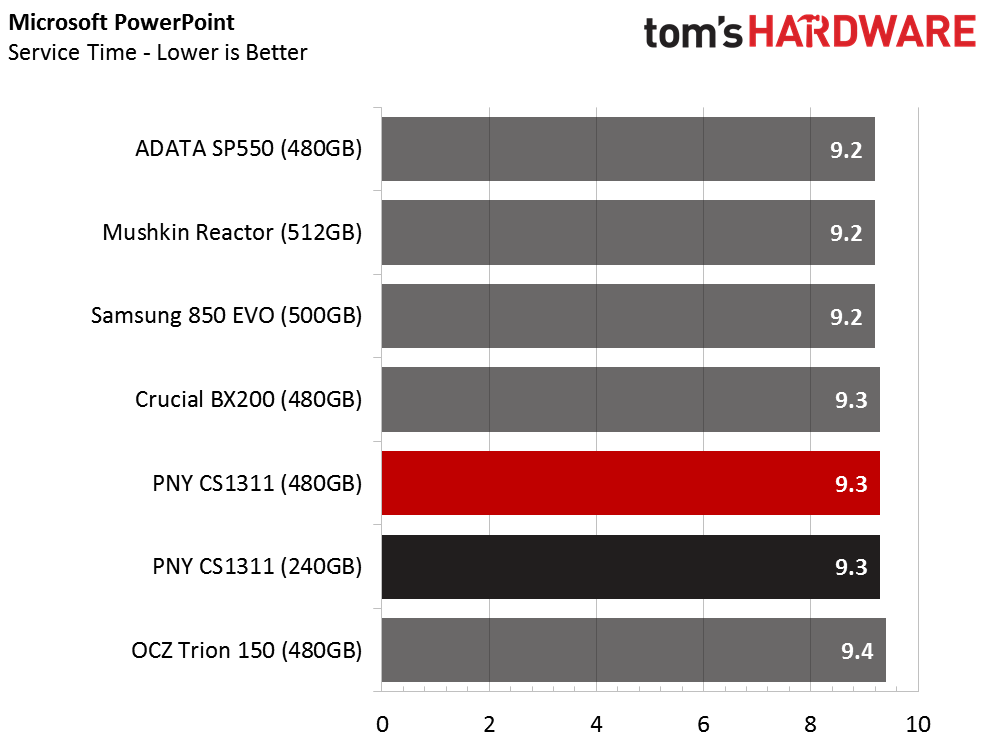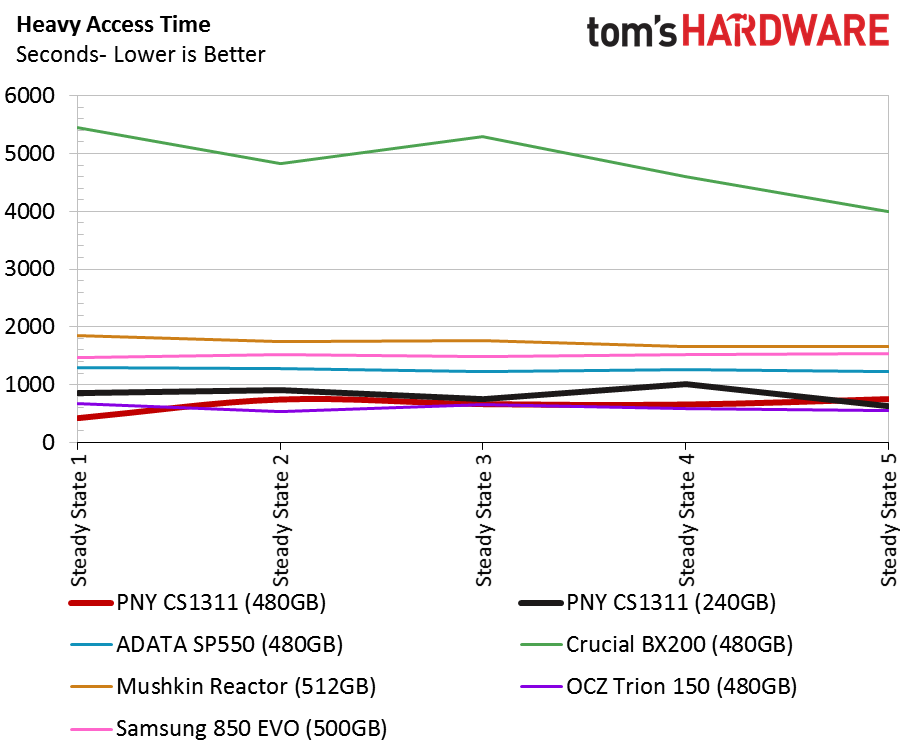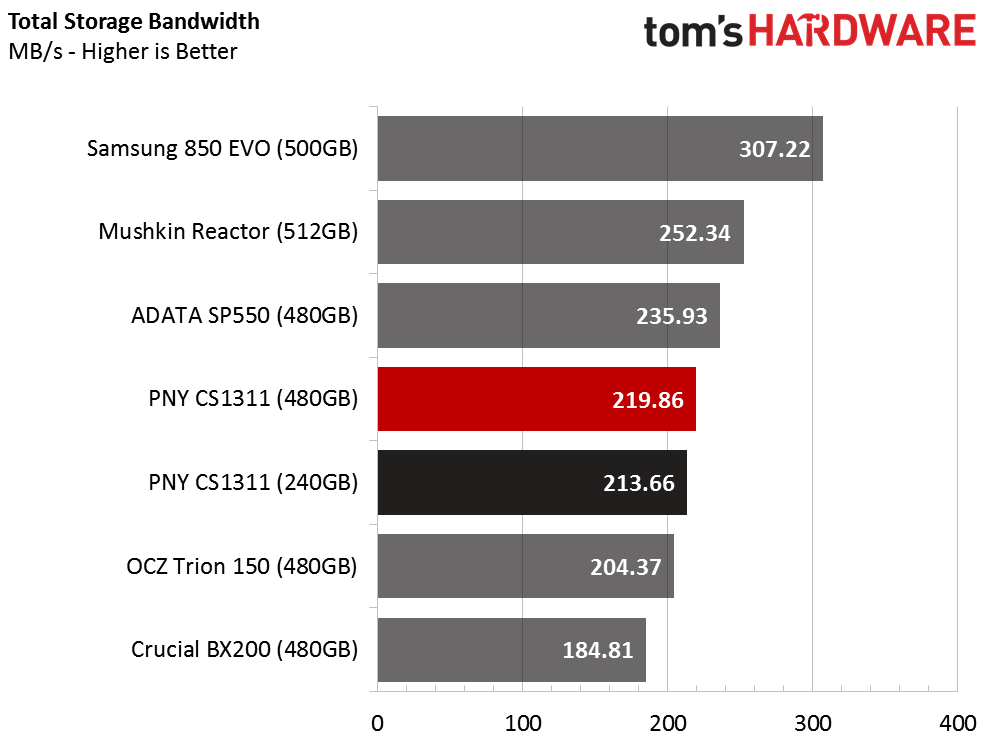PNY CS1311 SSD Review
Why you can trust Tom's Hardware
Real-World Software Performance
PCMark 8 Real-World Software Performance
For details on our real-world software performance testing, please click here.










It's difficult for most of us to derive meaning from IOPS, but we all understand time. And getting a time-based benchmark result from software we're all familiar with is even better. If you already have an SSD in your system, then these results should come close to what you see now. But anyone with a mechanical hard drive will appreciate the difference, since disk-based storage often takes twice as long to load basic applications compared to entry-level SSDs.
You can see in the results below that drives are sometimes separated by tenths of a second, which doesn't seem like much.
But the story changes when you look at the throughput of all applications combined and averaged together. The CS1311 SSDs manage to land in the middle of our hierarchy. They're both faster than OCZ's Trion 150 and Crucial's BX200, but can't match Adata's 480GB SP550.
PCMark 8 Advanced Workload Performance
To learn how we test advanced workload performance, please click here.



The PCMark 8 Storage Test operates with very little data on the drive. Performance changes when an SSD is full or nearly full, though. This set of measurements involves lots of data monopolizing the flash. When it comes to entry-level SSDs, we only look at the test's recovery stages. The degrade and steady state stages are more indicative of workstation-class loads, and they fall outside of what you'll see in a mainstream PC.
Phison's S10 controller is an eight-core processor with the resources to dedicate to background activities like garbage collection and wear-leveling. When its associated NAND is almost full, the extra cores help maintain performance. This test uses a five-minute think time (pause in reads and writes), which seems to be enough for the SLC buffer to purge data to the triple-level-cell flash.
Get Tom's Hardware's best news and in-depth reviews, straight to your inbox.
Total Access Time



Waiting on storage just doesn't feel right when you have an SSD under the hood. These tests continue to run on an almost full drive, though now we're reporting access times, which is essentially the latency from the combined tests.
PNY's CS1311s perform well under these conditions. This is one of the first entry-level SSD families able to compete against Samsung's 500GB 850 EVO during the test's recovery stage.
Notebook Battery Life


They don't, however, fare as well here, just like PNY's CS2211 XLR8 SSDs with Toshiba 15nm MLC flash. Three of the four PNY drives we've tested recently deliver 597 minutes of battery life in BAPCo's MobileMark 2012 software., while the top finisher approaches 700 minutes. This result isn't a deal-breaker, per se, but there are SSDs that facilitate better battery life, though.
Current page: Real-World Software Performance
Prev Page Mixed Workload And Steady State Next Page Conclusion
Chris Ramseyer was a senior contributing editor for Tom's Hardware. He tested and reviewed consumer storage.
-
cknobman Another one bites the dust.Reply
Sorry but I cannot see much of a reason to go with anything besides the Samsung right now.
-
2Be_or_Not2Be Thanks, Chris, for showing why we shouldn't buy this "one-step-back" SSD.Reply
It reminds me of when Honda introduced their new (new at the time) Insight hybrid. If you don't beat, match, or at least get very, very close to the market leader's (Prius) performance, you're not going to do very well with that model.
These "new" SSD models that have serious shortcomings aren't even worth purchasing for the price-savings over the EVO. -
3ogdy Yaaaaaaaaaaaaaaaaaaaaaaaaaaaaaaaaaaawn.Reply
There are so many players and products on the market in the SSD space right now that releasing more makes no sense unless there's anything special about it. They're all capped at SATA 6Gbps and performance sacrifices aren't worth the price difference ($7?!). I remember back in the day when SSDs were interesting. Now announcing a new SSD is like announcing a brand new higher-clocked Pentium IV CPU.
That's without even considering the already boring pricing on these things. Samsung's been selling the 500GB EVO for around $150 for way too long. Thankfully, they've come up with V-NAND, otherwise SSDs feel like '90s products already. At least 10 years on the market and no progress (thank you, SATA). Wake me up when 500GB drives are sold for less than $100 and then, maybe then, we could get this whole turtoise of an industry just a frucking bit forward. Until then, SSDs are not worth reviewing, except for a new case design they could feature. Meh. -
jojesa Most users wont see the difference in performance. I have installed both SSDs on the same Dell Latitude model and they bootup time, apps loading and shut down time looks exactly the same. I cannot tell the differences.Reply -
zodiacfml Please don't praise the Samsung too much as we don't want them monopolizing the SSD market. I think they are squeezing the prices down to prevent competitors from growing.Reply -
Jack_565 I would buy this just for the outward appearance of the SSD, if it goes on sale then i might consider one.Reply
Makes me wonder why cosmetic SSD Skins/Cases aren't a thing, ignoring voided warranties. -
mapesdhs Again nothing to compete usefully with the 850 EVO, though at least in the UK pricing for 850 EVOs has been going up a lot since xmas, especially the 250GB which reached a low of 53 UKP over the holiday season, but now is back right up to over 70 UKP. The 500GB has been more stable, and better value, but IMO a "good" SSD like the 850 EVO 500GB is not dropping below 100 UKP here because it doesn't need to. This happened before with the Samsung 830 a few years ago, people were happy to pay a lot more than the 125 UKP price offered by one UK seller for a couple of weeks (they sold over a thousand units), so pricing for 256GB models in general went up for several months.Reply
What happened to the competition SanDisk said they were going to bring to the market? I'm sure toms reported a couple of years ago that SanDisk was planning an 8TB model reasonably soon.

